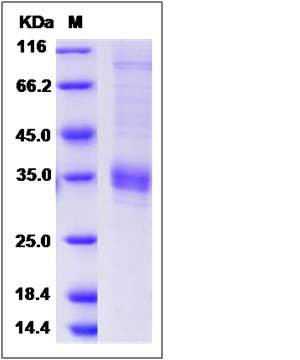Human BPIFA2 / C20orf70 Protein (His Tag)
bA49G10.1,C20orf70,PSP,SPLUNC2
- 100ug (NPP1936) Please inquiry
| Catalog Number | P13915-H08H |
|---|---|
| Organism Species | Human |
| Host | Human Cells |
| Synonyms | bA49G10.1,C20orf70,PSP,SPLUNC2 |
| Molecular Weight | The recombinant human C20orf70 consists of 242 amino acids and predicts a molecular mass of 26.5 KDa. It migrates as an approximately 35 KDa band in SDS-PAGE under reducing conditions. |
| predicted N | Glu 19 |
| SDS-PAGE |  |
| Purity | > 85 % as determined by SDS-PAGE |
| Protein Construction | A DNA sequence encoding the human C20orf70 (Q96DR5) (Met1-Ile249) was expressed with a polyhistidine tag at the C-terminus. |
| Bio-activity | |
| Research Area | Immunology |Signal Transduction |Metabolism |Pathways and Processes |Metabolic signaling pathways |Lipid and lipoprotein metabolism | |
| Formulation | Lyophilized from sterile PBS, pH 7.4 1. Normally 5 % - 8 % trehalose, mannitol and 0.01% Tween80 are added as protectants before lyophilization. Specific concentrations are included in the hardcopy of COA. |
| Background | C20orf70 belongs to the BPI/LBP/Plunc superfamily, Plunc family. PLUNC family is comprised by mucosal secretory proteins that are predicted to be structurally similar to lipid-binding and host-defense proteins including bactericidal/permeability-increasing protein and lipopolysaccharide-binding protein. C20orf70 can be detected in submandibular gland. C20orf70 gene contains 9 distinct gt-ag introns. Transcription produces 6 different mRNAs, 4 alternatively spliced variants and 2 unspliced forms. There are 2 probable alternative promotors, 3 non overlapping alternative last exons and 4 validated alternative polyadenylation sites. The mRNAs appear to differ by truncation of the 3' end. 80 bp of this gene are antisense to spliced gene glopa, raising the possibility of regulated alternate expression. C20orf70 is expected to have molecular function (lipid binding) and to localize in extracellular region. It is a salivary protein of unknown function. |
| Reference |
